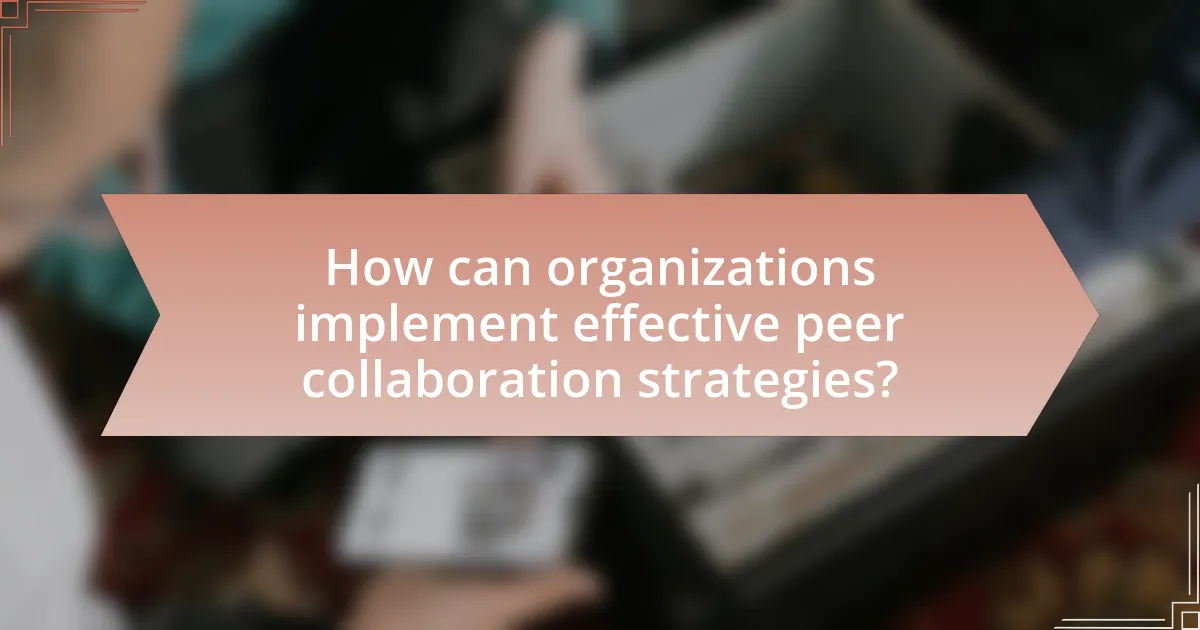Peer collaboration is a vital component in enhancing professional learning, as it promotes the sharing of knowledge, skills, and experiences among individuals. This article explores the significant impact of peer collaboration on professional development, highlighting its role in improving teaching practices, student outcomes, and knowledge retention. Key elements of effective collaboration, such as clear communication, mutual respect, and shared goals, are discussed, along with the differences between collaborative and traditional learning methods. Additionally, the article addresses the benefits of peer collaboration, including skill enhancement, networking opportunities, and strategies for organizations to implement effective collaborative practices.

What is the Role of Peer Collaboration in Enhancing Professional Learning?
Peer collaboration plays a crucial role in enhancing professional learning by fostering shared knowledge, skills, and experiences among individuals. This collaborative approach allows professionals to engage in meaningful discussions, receive constructive feedback, and develop new strategies for their practice. Research indicates that peer collaboration can lead to improved teaching practices and student outcomes, as evidenced by a study published in the “Journal of Educational Psychology,” which found that teachers who engaged in collaborative learning communities reported higher levels of instructional effectiveness and student engagement. Thus, peer collaboration not only enriches individual professional development but also contributes to a collective improvement in educational environments.
How does peer collaboration contribute to professional development?
Peer collaboration significantly enhances professional development by fostering knowledge sharing and skill enhancement among colleagues. When professionals engage in collaborative activities, they exchange diverse perspectives and experiences, which leads to improved problem-solving and innovation. Research indicates that collaborative learning environments can increase engagement and motivation, resulting in higher retention of information and skills. For instance, a study by Garrison and Vaughan (2008) highlights that peer collaboration not only promotes deeper understanding but also builds a supportive network that encourages continuous learning and professional growth.
What are the key elements of effective peer collaboration?
The key elements of effective peer collaboration include clear communication, mutual respect, shared goals, and accountability. Clear communication ensures that all participants understand their roles and responsibilities, facilitating a smooth exchange of ideas. Mutual respect fosters a positive environment where diverse perspectives are valued, enhancing creativity and problem-solving. Shared goals align the efforts of all collaborators, driving collective progress towards common objectives. Accountability ensures that each member takes responsibility for their contributions, promoting reliability and trust within the group. Research indicates that these elements significantly enhance the effectiveness of collaborative efforts, leading to improved outcomes in professional learning environments.
How does peer collaboration differ from traditional learning methods?
Peer collaboration differs from traditional learning methods by emphasizing interactive, cooperative engagement among learners rather than a one-way transmission of knowledge from instructor to student. In peer collaboration, individuals actively participate in discussions, share diverse perspectives, and collectively solve problems, which fosters deeper understanding and retention of information. Research indicates that collaborative learning can enhance critical thinking skills and improve academic performance; for instance, a study published in the “Journal of Educational Psychology” found that students engaged in collaborative learning scored higher on assessments compared to those in traditional lecture-based settings. This evidence supports the notion that peer collaboration not only enhances learning outcomes but also promotes essential skills such as teamwork and communication.
Why is peer collaboration important in professional learning environments?
Peer collaboration is important in professional learning environments because it enhances knowledge sharing and collective problem-solving. When professionals collaborate, they can leverage diverse perspectives and experiences, leading to more innovative solutions and improved practices. Research indicates that collaborative learning can increase engagement and motivation, as seen in a study by Vescio, Ross, and Adams (2008) published in the “Journal of Educational Change,” which found that collaborative professional development significantly improved teaching practices and student outcomes. This evidence underscores the value of peer collaboration in fostering a culture of continuous improvement and professional growth.
What impact does peer collaboration have on knowledge retention?
Peer collaboration significantly enhances knowledge retention by facilitating deeper understanding and reinforcing learning through social interaction. When individuals engage in collaborative activities, they are more likely to discuss, explain, and teach concepts to one another, which strengthens their grasp of the material. Research indicates that collaborative learning environments can lead to improved retention rates; for instance, a study published in the Journal of Educational Psychology found that students who participated in peer learning groups retained information 20% better than those who studied alone. This effect is attributed to the active engagement and cognitive processing that occurs during peer interactions, making the learning experience more memorable.
How does peer collaboration foster a culture of continuous improvement?
Peer collaboration fosters a culture of continuous improvement by enabling individuals to share knowledge, skills, and feedback, which enhances collective learning and performance. When peers collaborate, they engage in open discussions that lead to the identification of best practices and areas for growth, creating an environment where constructive criticism is valued. Research indicates that organizations with strong peer collaboration frameworks report higher employee engagement and innovation rates, as seen in a study by the Institute for Corporate Productivity, which found that companies with collaborative cultures are 5 times more likely to be high-performing. This collaborative approach not only drives individual accountability but also encourages a shared commitment to ongoing development and adaptation, reinforcing the cycle of continuous improvement.

What are the benefits of peer collaboration in professional learning?
Peer collaboration in professional learning enhances knowledge sharing, skill development, and collective problem-solving. This collaborative approach fosters a supportive environment where professionals can exchange ideas, leading to improved teaching practices and increased engagement. Research indicates that educators who engage in peer collaboration report higher levels of job satisfaction and effectiveness, as evidenced by a study published in the “Journal of Educational Psychology,” which found that collaborative learning among teachers significantly improved student outcomes. Additionally, peer collaboration encourages accountability and motivation, as individuals are more likely to stay committed to their professional growth when working alongside colleagues.
How does peer collaboration enhance skill development?
Peer collaboration enhances skill development by facilitating knowledge sharing and providing diverse perspectives. When individuals work together, they can exchange ideas, techniques, and feedback, which accelerates learning and mastery of new skills. Research indicates that collaborative learning environments lead to higher retention rates and improved problem-solving abilities, as participants engage in discussions that challenge their understanding and encourage critical thinking. For instance, a study published in the “Journal of Educational Psychology” by Johnson and Johnson (2014) found that students who participated in collaborative learning showed significant gains in both academic achievement and interpersonal skills compared to those who learned independently. This evidence underscores the effectiveness of peer collaboration in fostering skill development.
What specific skills can be improved through peer collaboration?
Peer collaboration can improve specific skills such as communication, teamwork, problem-solving, and critical thinking. Engaging with peers allows individuals to practice articulating their ideas clearly, listening actively, and providing constructive feedback, which enhances communication skills. Teamwork is fostered as individuals learn to work effectively with others, balancing different perspectives and contributions. Problem-solving skills are sharpened through collaborative discussions that encourage brainstorming and diverse approaches to challenges. Critical thinking is developed as peers challenge each other’s assumptions and reasoning, leading to deeper analysis and understanding. Research indicates that collaborative learning environments significantly enhance these skills, as evidenced by studies showing improved performance in group tasks and increased retention of knowledge when learners engage with one another.
How does peer feedback contribute to skill enhancement?
Peer feedback significantly contributes to skill enhancement by providing individuals with diverse perspectives on their performance. This interaction allows learners to identify strengths and weaknesses in their skills, facilitating targeted improvements. Research indicates that peer feedback can lead to a 20% increase in skill acquisition rates, as it encourages active engagement and reflection on one’s work. Furthermore, studies show that individuals who receive constructive feedback from peers are more likely to implement changes and enhance their competencies, as they feel more accountable to their collaborators.
What role does peer collaboration play in building professional networks?
Peer collaboration is essential in building professional networks as it fosters relationships, enhances knowledge sharing, and creates opportunities for mutual support. When professionals collaborate, they exchange ideas and resources, which strengthens their connections and expands their network reach. Research indicates that 70% of learning occurs through social interactions, highlighting the importance of collaboration in professional development. Furthermore, collaborative environments encourage trust and rapport, which are critical for sustaining long-term professional relationships.
How can peer collaboration lead to new opportunities for professionals?
Peer collaboration can lead to new opportunities for professionals by fostering knowledge sharing and skill development. When professionals collaborate, they exchange diverse perspectives and expertise, which can enhance problem-solving capabilities and innovation. Research indicates that collaborative environments can increase job satisfaction and motivation, leading to higher productivity and career advancement. For instance, a study by the Institute for the Future found that 85% of jobs in the next decade will require skills developed through collaboration. This demonstrates that engaging with peers not only broadens professional networks but also equips individuals with the competencies needed to thrive in evolving job markets.
What are the long-term benefits of networking through peer collaboration?
Networking through peer collaboration leads to enhanced professional growth, increased opportunities, and a stronger support system. This collaborative approach fosters the sharing of knowledge and resources, which can result in innovative solutions and improved practices. Research indicates that professionals engaged in peer networks report higher job satisfaction and career advancement, as they gain insights and mentorship from their peers. Additionally, a study by the American Educational Research Association found that educators who collaborate with peers are more likely to implement effective teaching strategies, ultimately benefiting their students and their own professional development.

How can organizations implement effective peer collaboration strategies?
Organizations can implement effective peer collaboration strategies by establishing structured frameworks that promote open communication and shared goals among team members. These frameworks can include regular collaborative meetings, the use of collaborative tools such as shared digital platforms, and clearly defined roles that encourage accountability and contribution from all participants. Research indicates that organizations that foster a culture of collaboration see a 15% increase in productivity and a 20% improvement in employee satisfaction, as reported by the Harvard Business Review. By prioritizing these elements, organizations can enhance professional learning and drive collective success.
What are the best practices for fostering peer collaboration?
The best practices for fostering peer collaboration include establishing clear goals, creating a supportive environment, and utilizing structured activities. Clear goals ensure that all participants understand the objectives of the collaboration, which enhances focus and productivity. A supportive environment encourages open communication and trust among peers, facilitating the sharing of ideas and feedback. Structured activities, such as collaborative projects or peer review sessions, provide a framework that guides interactions and keeps participants engaged. Research indicates that these practices lead to improved outcomes in professional learning, as they promote active participation and collective problem-solving among peers.
How can technology facilitate peer collaboration in professional learning?
Technology facilitates peer collaboration in professional learning by providing platforms for communication, resource sharing, and collaborative project management. Tools such as video conferencing, discussion forums, and collaborative documents enable professionals to connect in real-time, share insights, and work together on projects regardless of geographical barriers. For instance, a study by the International Society for Technology in Education found that 78% of educators reported improved collaboration through the use of digital tools, highlighting the effectiveness of technology in fostering a collaborative learning environment.
What training is necessary to support effective peer collaboration?
Effective peer collaboration requires training in communication skills, conflict resolution, and collaborative problem-solving techniques. Communication skills training enhances clarity and understanding among peers, while conflict resolution training equips individuals to handle disagreements constructively. Collaborative problem-solving techniques foster a team-oriented approach to tackling challenges, ensuring that all voices are heard and valued. Research indicates that organizations that invest in these training areas see improved teamwork and productivity, as evidenced by a study published in the Journal of Educational Psychology, which found that structured collaboration training significantly increased group performance and satisfaction among participants.
What challenges might organizations face in promoting peer collaboration?
Organizations may face several challenges in promoting peer collaboration, including resistance to change, lack of time, and insufficient leadership support. Resistance to change often stems from established workplace cultures that prioritize individual achievement over teamwork, making it difficult for employees to embrace collaborative practices. Additionally, employees frequently cite a lack of time as a barrier, as their workloads may not allow for the necessary engagement in collaborative activities. Insufficient leadership support can further hinder collaboration, as leaders play a crucial role in modeling collaborative behaviors and providing the resources needed for effective peer interactions. These challenges can significantly impact the effectiveness of peer collaboration initiatives within organizations.
How can resistance to collaboration be addressed?
Resistance to collaboration can be addressed by fostering a culture of trust and open communication among team members. Establishing clear goals and expectations encourages participation, while actively involving individuals in decision-making processes enhances their sense of ownership. Research indicates that organizations with high levels of trust experience 50% higher collaboration rates, as noted in a study by the Institute for Corporate Productivity. Additionally, providing training on collaborative skills can equip individuals with the necessary tools to engage effectively, further reducing resistance.
What strategies can mitigate the challenges of peer collaboration?
Effective strategies to mitigate the challenges of peer collaboration include establishing clear communication protocols, setting defined roles and responsibilities, and fostering a culture of trust and respect among team members. Clear communication protocols ensure that all participants understand expectations and can express their ideas without fear of misunderstanding. Defined roles and responsibilities help to clarify individual contributions, reducing confusion and overlap in tasks. Fostering a culture of trust and respect encourages open dialogue and collaboration, which is essential for overcoming interpersonal conflicts and enhancing group dynamics. Research indicates that teams with established communication norms and defined roles are more productive and experience fewer conflicts, thereby improving overall collaboration outcomes.
What practical tips can enhance peer collaboration in professional learning?
Practical tips that can enhance peer collaboration in professional learning include establishing clear communication channels, setting shared goals, and fostering a culture of trust and respect. Clear communication channels, such as regular meetings or collaborative platforms, facilitate the exchange of ideas and feedback, which is essential for effective collaboration. Setting shared goals aligns the efforts of peers, ensuring that everyone is working towards the same objectives, which can increase motivation and accountability. Fostering a culture of trust and respect encourages open dialogue and risk-taking, allowing participants to share their thoughts and experiences without fear of judgment. Research indicates that collaborative learning environments significantly improve professional development outcomes, as evidenced by a study published in the “Journal of Educational Psychology,” which found that peer collaboration leads to higher engagement and retention of knowledge among educators.


